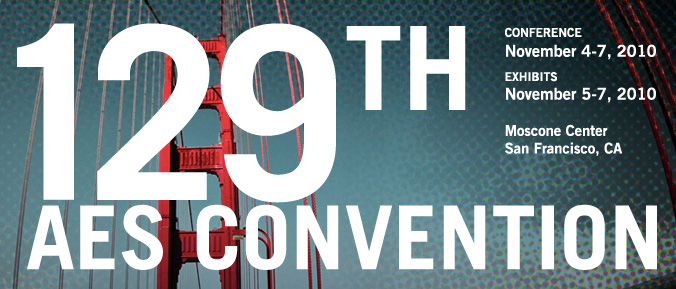
AES San Francisco 2010
Paper Session P27
Sunday, November 7, 2:30 pm — 5:00 pm (Room 236)
Paper Session: P27 - Room Acoustics
Chair:
Søren Bech
P27-1 First Results from a Large-Scale Measurement Program for Home Theaters—Tomlinson Holman, Ryan Green, University of Southern California - Los Angeles, CA, USA, Audyssey Laboratories, Los Angeles, CA, USA
The introduction of one auto-equalization system to the home theater market with an accompanying reporting infrastructure provides methods of data collection that allows research into many practical system installations. Among the results delivered are histograms of room volume, reverberation time vs. volume and frequency, early arrival sound frequency response both equalized and unequalized, and steady-state frequency response both equalized and unequalized. The variation in response over the listening area is studied as well and sheds light on contemporary use of the Schroeder frequency.
Convention Paper 8310 (Purchase now)
P27-2 Improving the Assessment of Low Frequency Room Acoustics Using Descriptive Analysis—Matthew Wankling, Bruno Fazenda, William J. Davies, University of Salford - Salford, Greater Manchester, UK
Several factors contribute to the perceived quality of reproduced low-frequency audio in small rooms. Listeners often use descriptive terms such as “boomy” or “resonant.” However a robust terminology for rating samples during listening tests does not currently exist. This paper reports on an procedure to develop such a set of subjective descriptors for low frequency reproduced sound, using descriptive analysis. The descriptors that resulted are Articulation, Resonance, and Bass Content. These terms have been used in listening tests to measure the subjective effect of changing three objective room parameters: modal decay time, room volume, and source/receiver position. Reducing decay time increased Articulation while increased preference is associated with increased Articulation and decreased Resonance.
Convention Paper 8311 (Purchase now)
P27-3 Subjective Preference of Modal Control Methods in Listening Rooms—Bruno M. Fazenda, Lucy A. Elmer, Matthew Wankling, J. A. Hargreaves, J. M. Hirst, University of Salford - Greater Manchester, UK
Room modes are well known to cause unwanted effects in the correct reproduction of low frequencies in critical listening rooms. Methods to control these problems range from simple loudspeaker/listener positioning to quite complex digital signal processing. Nonetheless, the subjective importance and impact of these methods has rarely been quantified subjectively. A number of simple control methods have been implemented in an IEC standard listening environment. Eight different configurations were setup in the room simultaneously and could therefore be tested in direct comparison to each other. A panel of 20 listeners were asked to state their preferred configuration using the method of paired comparison. Results show clear winners and losers, indicating an informed strategy for efficient control.
Convention Paper 8312 (Purchase now)
P27-4 Wide-Area Psychoacoustic Correction for Problematic Room Modes Using Non-Linear Bass Synthesis—Adam J. Hill, Malcolm O. J. Hawksford, University of Essex - Colchester, UK
Small room acoustics are characterized by a limited number of dominant low-frequency room modes that result in wide spatio-pressure variations that traditional room correction systems find elusive to correct over a broad listening area. A psychoacoustic-based methodology is proposed whereby signal components coincident only with problematic modes are filtered and substituted by virtual bass components to forge an illusion of the suppressed frequencies. A scalable and hierarchical approach is studied using the Chameleon Subwoofer Array (CSA), and subjective evaluation confirms a uniform large-area performance. Bass synthesis exploits parallel nonlinear and phase vocoder generators with outputs blended as a function of transient and steady-state signal content.
Convention Paper 8313 (Purchase now)
P27-5 Beyond Coding: Reproduction of Direct and Diffuse Sounds in Multiple Environments—James D. Johnston, DTS Inc. - Kirkland, WA, USA; Jean-Marc Jot, DTS Inc. - Scotts Valley, CA, USA; Zoran Fejzo,, DTS Inc. - Calabasas, CA, USA; Steve R. Hastings, DTS Inc. - Scotts Valley, CA, USA
For many years, the difference in perception between perceptually direct sounds (i.e., sounds with a specific direction) and perceptually diffuse sounds (i.e., sounds that "surround" or "envelop" the listener) have been recognized, leading to a variety of approaches for simulating or capturing these perceptual effects. Here, we discuss a system using separation of direct and diffuse signals, or for synthetic signals (e.g., those made by modern production methods) synthesis of the diffuse signal in one of several ways, in order to enable the reproduction system, after measuring the characteristics of the playback system, to provide the best possible sensation from that particular set of playback equipment.
Convention Paper 8314 (Purchase now)
